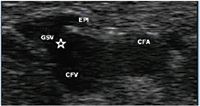Pelvic phlebology: an underappreciated emerging specialty?
Venous reflux from pelvic sources is often overlooked when evaluating gynecologic patients, argues an advocate of the newer discipline of phlebology. Pay special attention, he urges to those patients having pelvic pain and chronic venous insufficiency in their legs.
Phlebology, the medical discipline devoted to venous disease, is recognized by the AMA as a self-designated practice specialty. Chronic venous insufficiency (CVI) a frequently overlooked medical disorder, affects at least 25% of women and 15% of men.1,2 Left untreated, CVI can cause leg pain, swelling, thromboses, and varicose veins. In addition, patients may develop dermatologic skin changes of hyperpigmentation, lipodermatosclerosis, and venous stasis ulcers.3

Pelvic venous anatomy 101

As the CFV continues cephalad, it crosses below the inguinal ligament to become the external iliac vein. This vessel merges with the internal iliac (hypogastric) vein to form the common iliac vein. On the right side, this vein lies posterior and then medial to the iliac artery. On the left side, it courses entirely along the medial aspect of the iliac artery. At the level of the fifth lumbar vertebra, the right and left common iliac veins unite to give rise to the inferior vena cava (Figure 1). Here, the left common iliac vein courses behind the right common iliac artery.
The internal iliac (hypogastric) vein drains the pelvic viscera. Venous branches include the gluteal, internal pudendal, and obturator veins. The latter two provide venous drainage for the vulva.
The right ovarian vein drains directly into the inferior vena cava while the left ovarian vein drains into the left renal vein (Figure 1). The left renal vein often lies between the superior mesenteric artery and the abdominal aorta.
